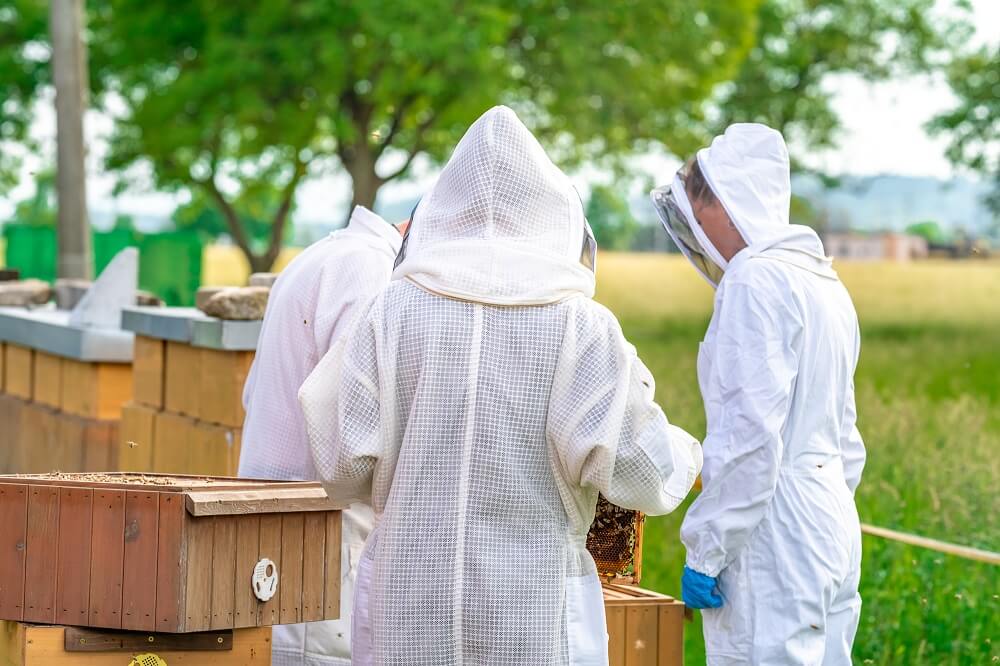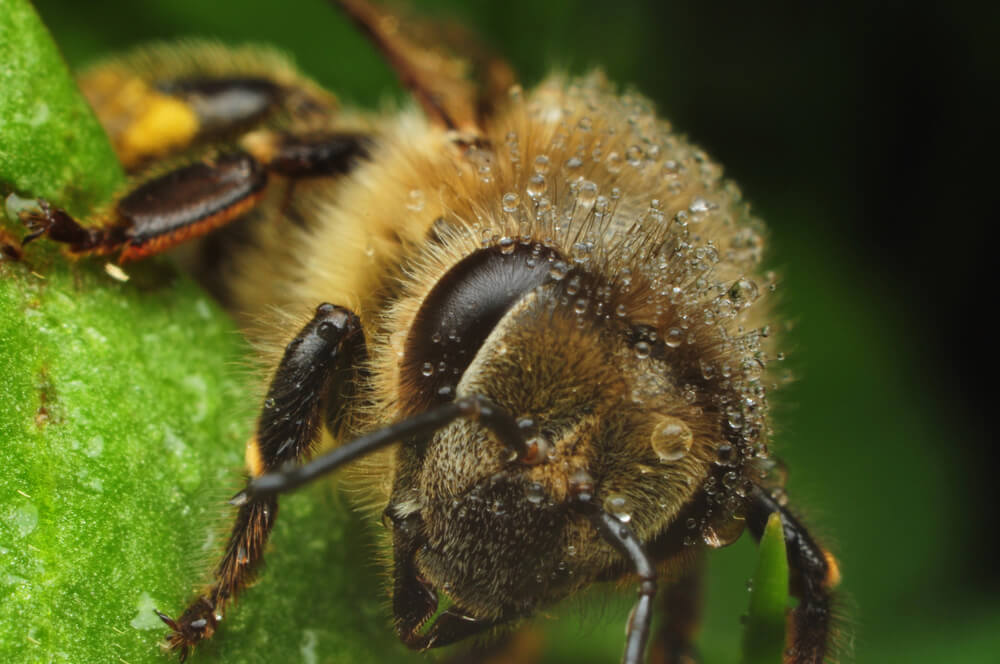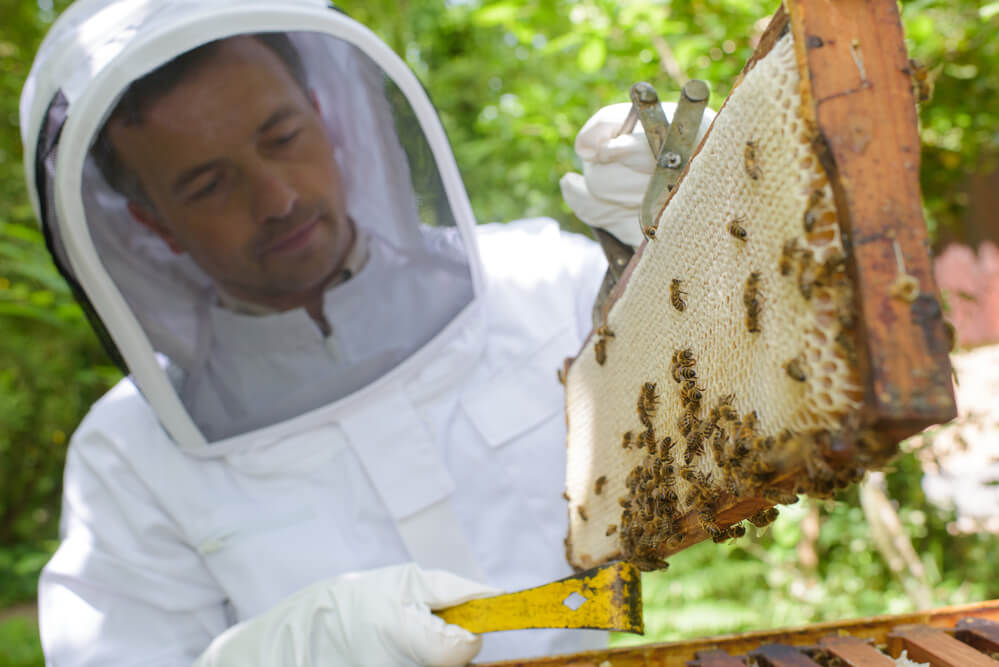Table of Contents:
What Is Festooning?
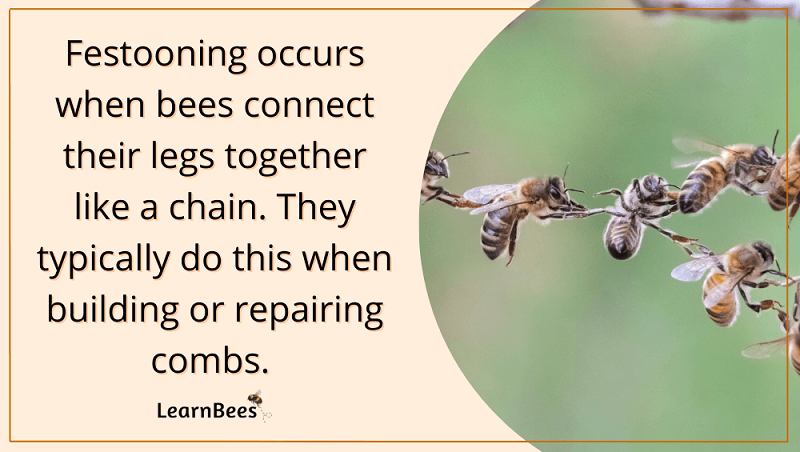
Festooning occurs when honey bees hang together like a chain. They have special hooks on their legs to hold each other securely.
Now the million-dollar question becomes…
Why do bees festoon?
If you ask a dozen different beekeepers, you’ll get many different answers.
The truth is, festooning is still a mystery. We have several theories on why bees festoon, but we’re still unsure. However, mysteries like this make honey bees so fascinating to study.
That said, here are the theories on why bees festoon:
- The honey bees are building or repairing comb: Bee festooning is most often seen when the colony is comb-building. The bees dangle between frames using teamwork to create a ladder.
- The honey bees are regulating the hive’s temperature: It’s believed that the festooning clusters allow the bees to maintain a consistent temperature. In turn, this can help them better create and mold beeswax.
- The honey bees are measuring: Like humans, bees can measure distances when building their homes. Creating a festoon allows the bees to determine the proper spacing between combs.
Festooning is most often observed by beekeepers who inspect their hives.
Now here’s the critical part:
Beekeepers separating frames of festooning bees should be extremely gentle. The bees are interlocked using the tarsus claws on their legs. If you move too fast, you risk ripping their feet off.
Instead, work incredibly slowly and methodically to allow the bees to unhook themselves.
What Is Bearding vs. Festooning?
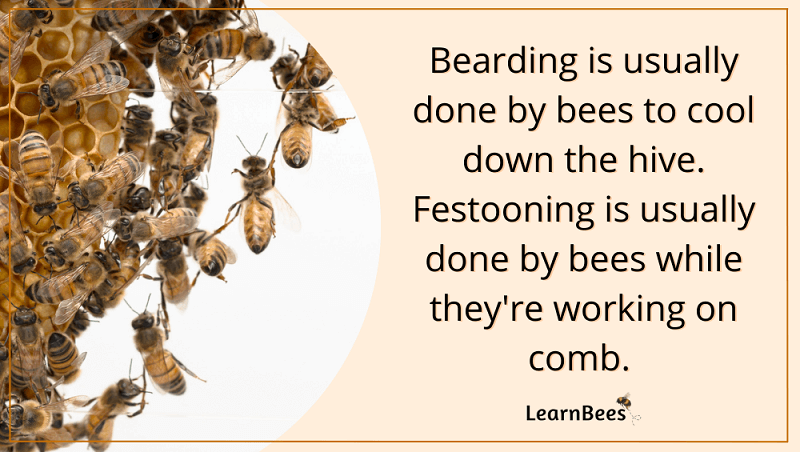
Bearding is when honey bees gather in a beard-like formation at the front of the hive. They typically do this to cool the hive by reducing the number of bees in it.
Festooning is when honey bees form a chain-like ladder inside the hive. Festooning happens when bees are building a comb.
Both bearding and festooning are common behaviors.
With that in mind, some beekeepers worry about bearding because it can also signify that the bees are preparing to swarm. Swarming occurs when half the colony leaves to find a new home.
However, swarming only occurs a few times per year at most.
As such, bearding is usually the result of bees reducing the hive’s temperature. Beekeepers can help bearding bees by adding ventilation. Sometimes adding a box can help to give them more space and reduce heat.
Besides that?
We don’t recommend interfering with the bearding process. Avoid scooping the honey bees back into the hive. The bees may stay bearded for several hours or even days. This is perfectly fine.
Honey bees have evolved strategies for their survival. Bearding is one of them.
What Are the Benefits of Festooning?
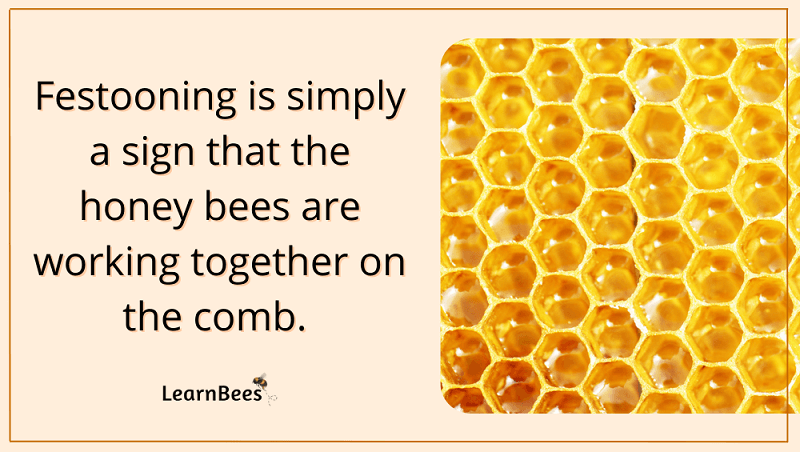
As mentioned, festooning is a behavior that we’re not totally clear on.
However, one theory is that bees festoon because it allows them to create or rebuild comb sections faster. Teamwork allows the bees to create a living scaffold.
Additionally, festooning can potentially be a measuring tool honey bees use to calculate the distance between frames.
Festooning also produces heat because the bees are clustered together. In turn, this can allow the bees to mold and manipulate the wax easier. The best temperature for creating and forming beeswax is over 86°F.
FAQs on Festooning
- What is it called when bees hold hands?
- Should I be concerned that my bees are festooning?
- What type of bees festoon?
- Where do bees festoon?
- How often do bees festoon?
- What’s the difference between festooning and washboarding?
- Why do honey bees cling together?
What is it called when bees hold hands?
The “hand-holding” activity is called festooning. The bees form a chain-like ladder and use teamwork to create, build or repair comb.
Beekeepers must be careful with festooning bees because they can accidentally rip their legs apart if they move them. Honey bees have tarsus claws that they use to interlock their legs together. When inspecting frames with festooning bees, you must move very slowly to allow them time to unhook themselves.
—> Go back to the FAQs on festooning
More to Explore:
Should I be concerned that my bees are festooning?
You should not be concerned that your honey bees are festooning. Festooning is a natural and beneficial behavior that bees sometimes use when building combs. You don’t want to interfere with this process.
—> Go back to the FAQs on festooning
More to Explore:
What type of bees festoon?
Currently, honey bees are the only known species of bee that festoons.
However, it’s possible that other social bee species festoon, but the research on that is limited. This is mainly because honey bees are the most widely studied bee species since beekeeping has been a popular hobby for centuries.
With that said, honey bees are the only bee species that produce enough honey for human consumption.
Other bees, like bumble bees, produce honey too. But bumble bees don’t produce honey on nearly the scale as honey bees. They also don’t produce as much wax, so it’s less likely that bumble bees exhibit festooning behavior.
Bumble bees simply repair their wax pots by crawling over them. They don’t necessarily need to form a chain-like ladder because they don’t create dangling combs like honey bees.
—> Go back to the FAQs on festooning
More to Explore:
Where do bees festoon?
Honey bees festoon inside their hive or nest. It’s common for beekeepers to observe festooning when they’re inspecting frames.
Beekeepers must work slowly and gently when inspecting festooning bees. If beekeepers rush too quickly, it can seriously harm the honey bees’ legs by ripping their feet off. Honey bees have tarsus claws that securely interlock their feet when festooning.
—> Go back to the FAQs on festooning
More to Explore:
- How Many Bees Are in a Hive?
- What is Backyard Beekeeping?
- Honey Extractors 101: Everything You Need to Know
How often do bees festoon?
There is no set time or date that the honey bees’ festoon on. They simply do it when they need to repair or create comb. It’s an instinctive behavior that doesn’t necessarily happen daily.
—> Go back to the FAQs on festooning
More to Explore:
What’s the difference between festooning and washboarding?
Washboarding is another mysterious honey bee behavior that’s fascinating to watch.
Washboarding occurs when worker bees gather in large groups and rock back and forth. While doing so, they appear to be licking the surface below them. Washboarding can happen inside or outside the hive, and some entomologists believe it’s a cleaning behavior.
On the other hand, festooning is when bees form a chain-like ladder and use teamwork to create or repair comb.
—> Go back to the FAQs on festooning
More to Explore:
- How Many Brood Boxes Should I Start With?
- How to Identify and Handle Queen Cells
- What Direction Should a Beehive Face?
Why do honey bees cling together?
People often ask:
What is the purpose of festooning? Why do bees bridge? What does it mean when bees are festooning?
The answer is that bees cling together for various reasons.
For example, festooning is a cooperative behavior used to create or repair comb inside the hive. You can think of it as construction behavior. This process requires many worker bees, so they clasp their legs together to form a scaffold.
Here are a few theories on why bees festoon:
- Bees festoon when constructing or repairing comb: They quite literally build a ladder to hang between frames. This phenomenon occurs with the help of teamwork and coordination among several colony members.
- Honey bees regulate their wax temperature by forming a festooning cluster: This enables them to maintain consistent temperatures that allow them to mold and shape beeswax. Warmer beeswax is easier to manipulate.
- Honey bees use festooning for measuring: By forming a festoon, they can accurately calculate the distance between two combs while constructing their hives.

